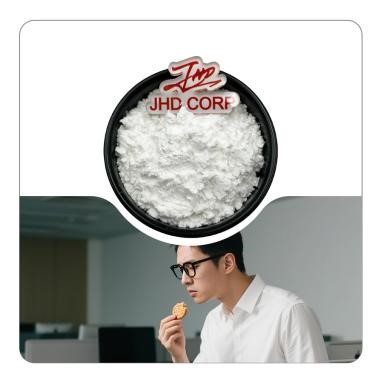Welcome to JHD Nutrasource!
Shop
Ferric Pyrophosphate Powder
Ferric pyrophosphate is an inorganic iron salt with the chemical formula Fe₄(P₂O₇)₃. It appears as a pale yellow to yellow – white powder1. It is slightly soluble in water and acetic acid, but soluble in inorganic acids, ammonia, alkali solutions, and citric acid3. The iron content is 24.0% – 26.0%3. It has a faint iron taste. It is stable in nature, not easily oxidized, and has good compatibility with other components.
Description
| Product Name | Ferric Pyrophosphate Powder |
| Appearance | White to light yellow powder |
| Specification | 97% |
| Test Method | ICP-MS |
| Source | through a chemical process |
| Certificate | USP/EP/JP/Kosher/Halal/GMP |
| CAS No | 10058-44-3 |
| MF No | Fe₄(P₂O₇)₃ |
Functions
- Nutritional Supplement: Iron is an essential trace element for the human body, playing a crucial role in the formation of hemoglobin. Ferric pyrophosphate is mainly used as an iron – fortifying agent, which can effectively prevent iron – deficiency anemia. It can supplement the iron lost in modern refined foods and is of great significance for maintaining the normal physiological functions of the human body.
- Other Functions: It can also be used as a corrosion – resistant pigment, catalyst, and flame – retardant for synthetic fibers. In the pharmaceutical industry, it is used to prepare iron – supplement drugs for the treatment of iron – deficiency anemia in patients with chronic kidney disease undergoing dialysis.
Applications
- Food Industry: It is used as an iron – fortifying agent in foods such as flour, biscuits, bread, milk powder, rice flour, and soy milk powder. In foreign countries, it is also used in infant formula, health food, convenience food, and functional juice drinks. It does not change the color and taste of food and does not react with other nutrients, which helps to improve the nutritional value of food.
- Pharmaceutical Industry: It is used as an ingredient in iron – supplement drugs, usually in the form of tablets, capsules, and syrups, which are used to treat iron – deficiency anemia. It can also be used as a raw material for some pharmaceutical preparations to improve the iron content of the drug and enhance the therapeutic effect.
- Other Industries: In the chemical industry, it is used as a catalyst for some chemical reactions. In the textile industry, it is used as a flame – retardant for synthetic fibers to improve the fire – resistance of fabrics. In addition, it can also be used as a corrosion – resistant pigment to improve the anti – corrosion performance of coatings.

